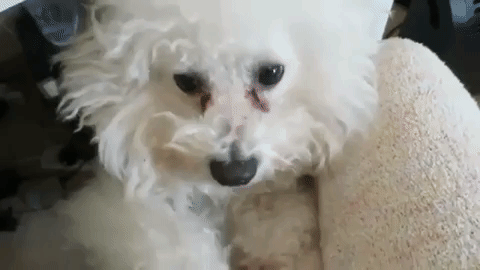Are your dog’s symptoms minor and not a cause for concern? Or is your dog struggling to deal with changes in the environment? Here are some signs of a dog in distress and how to address them.
There are many things which can lead to dog distress, but fortunately by taking the right approach you should be able to reverse this. This article will explain some of the critical causes of stress in dogs and how you can use acupressure for dogs to control or eliminate them, bringing your dog back to a calmer state.

The signs of a dog in distress can be hard to spot, especially if you don’t know what to look for.
In most cases, dogs try to hide their pain and discomfort. They may not want to let you know that they are hurting or sick, so it’s important that you learn how to read your dog’s body language.
Here are some signs that your dog is in distress:
-If your dog has lost its appetite, this could be a sign that something is wrong. If you notice that your dog has been eating less than usual, take them to the vet immediately.
-If your dog seems lethargic and tired all the time, this could be a sign of illness or stress. If your dog used to have energy but now seems like they are running on empty, take them to see the vet right away.
-If your dog is vomiting or having diarrhea regularly, this could be a sign of illness or stress. If you notice that your dog has been vomiting or having diarrhea more than normal lately, take them in for an examination as soon as possible.
Determining if your dog is in distress can be tricky.
Dogs have a tendency to hide their symptoms, and many of them will mask pain by acting like everything is normal. This can make it difficult to tell if your dog is truly in distress.
However, there are some signs that may indicate your dog is not feeling well or may need help:
-Lethargy
-Restlessness or pacing
-Excess salivation or drooling
-Change in appetite (eating more or less than normal)
Signs Of A Dog In Distress
When did you last feel frustrated by someone who had a dog?
For me, it was this morning. My dog, Pogs, was enjoying a game of fetch across the sand. Enter 3 other dogs over the crest of a dune.
Two of them peeled away and headed straight for Pogs, who is smaller and was outnumbered. The dogs gave chase, snapping at her back.
With her eyes rolling, ears pinned back and tail between her legs, Pogs was clearly distressed. Yet the other dogs’ people did nothing.
“They’re only playing!” they shouted, as the larger dog growled and grabbed again at Pogs’s haunches.
They were missing the point — sure, their dogs were having a fabulous time. But my dog was terrified. Surely they could recognize signs that a dog is distressed, right?
When you recognize stress in your dog or another, you can take steps to diffuse the situation. Failing to do so is not only unfair but in some cases could end up with the stressed dog biting out of self-defense.
Let’s avoid this unpleasant scenario by refreshing ourselves on what a stressed dog looks like in 4 different scenarios …

Scenario 1: The Dog Is Stressed by Other Dogs
An anxious dog uses body language to tell other dogs to back off.
These signals communicate either that they are no threat and so there’s no need to approach, or that they are unhappy but prepared to attack if pressed.
The dog whose signals are ignored may snap to make the threat go away and unwittingly become labeled as aggressive.
Signs That the Dog Is Distressed
An anxious dog will first use subtle body language to diffuse the situation. For example:
- Lowered head carriage
- Turned the head aside to avoid staring directly at the approaching dog
- Whale eyes, where the white cornea shows around the iris
- Lowered ears
- Tail tucked between the back legs
- Raised hackles over the shoulders (a sign of severe anxiety or fear)
- Displaying the belly (a sign of submission — can be a desperate attempt to appease another dog)
Hopefully, the other dog reads the body language and backs off. If not, then it’s up to the responsible human to call their pet away.

Scenario 2: The Dog Is Outside Their Comfort Zone
A typical example of a dog outside their comfort zone is a trip to the veterinarian.
Signs That the Dog Is Distressed
Here, the dog may display subtle signs of distress, including:
- Yawning
- Lip licking
- Lifting a paw
- Backing away
- Barking
- Growling and aggression
In these circumstances, any vet worth her salt will give these dogs time to adjust by ignoring them.
This is a great time to take a medical history — when the dogs see their humans relaxed and chatting with the vet, it puts them at ease.

Scenario 3: The Dog Is Experiencing Separation Anxiety
Most people have heard of separation anxiety in dogs, but some may not be aware of the subtle signs.
Signs That the Dog Is Distressed
If your neighbor complains about the dog’s barking when you’re out, this could indeed be a sign the dog is not coping well with your absence. Other signs include:
- Destructiveness, such as chewing or digging
- Peeing or pooping in the house when left alone
- Excessive barking or howling
- Hiding
- Extreme clinginess before your departure
If this sounds familiar, then avoid having a predictable routine before leaving and make as little fuss about going as possible.
Consider speaking with a behaviorist about a strategy for breaking the association between solitude and distress in your dog.

Scenario 4: The Dog Is Stressed by Life
A dog can be stressed by a change of routine, such as you returning to work, having a new pet in the house or even mourning the death of a loved one.
Signs That the Dog Is Distressed
Signs to be vigilant for include:
- Changes in appetite, such as eating less
- Becoming withdrawn and hiding away
- Not engaging in play or enjoying favorite toys in the same way
- Behavioral changes, such as becoming snappy for no reason
- Sleeping more
- “Self-harm” habits, such as excessive licking of one spot or chewing fur out
Many of these signs are vague and can also indicate ill health.